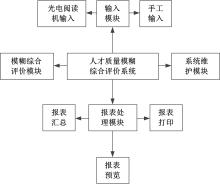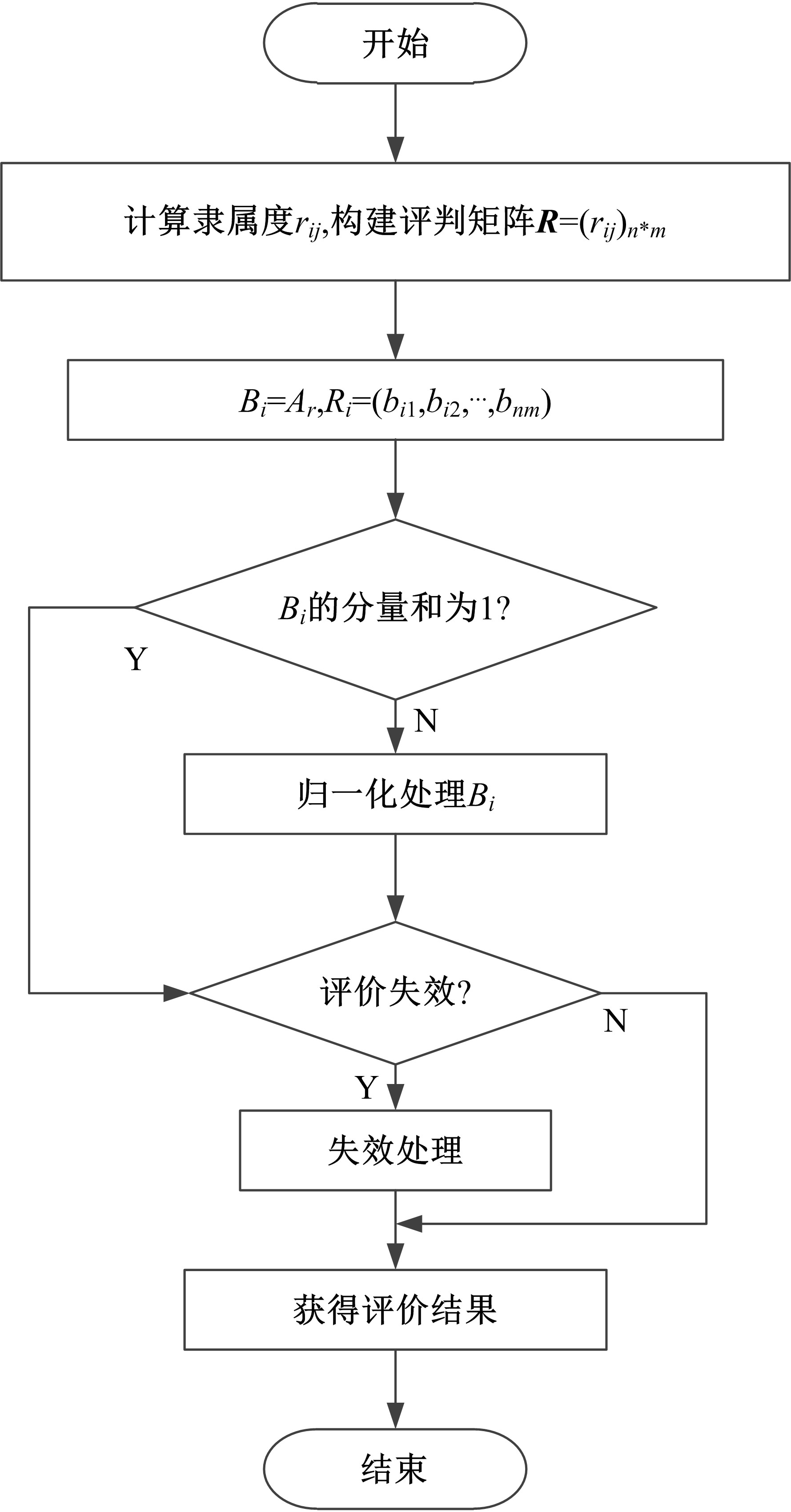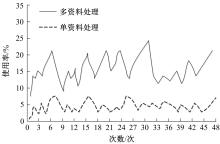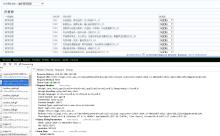吉林大学学报(工学版) ›› 2020, Vol. 50 ›› Issue (5): 1856-1861.doi: 10.13229/j.cnki.jdxbgxb20190923
• 计算机科学与技术 • 上一篇
基于多目标进化算法的人才质量模糊综合评价系统设计
- 1.吉林大学 人才工作办公室,长春 130011
2.吉林大学 计算机科学与技术学院,长春 130011
Design of fuzzy comprehensive evaluation system for talent quality based on multi⁃objective evolutionary algorithm
- 1.Office of Talent Work,Jilin University,Changchun 130011, China
2.College of Computer Science and Technology, Jilin University,Changchun 130011, China
摘要:
针对当前评价系统评价人才质量时出现的评价误差大、效率和准确率低的问题,提出了基于多目标进化算法的人才质量模糊综合评价系统设计方法。该方法通过输入模块、模糊综合评价模块、报表处理模块和系统维护模块构成人才质量模糊综合评价系统的整体结构。采用层次分析法对人才质量评价指标对应的权重进行计算,构建人才质量模糊综合评价模型,然后采用多目标进化算法对人才质量模糊综合评价模型进行求解,实现人才质量的评价,完成人才质量模糊综合评价系统的设计。实验结果表明:本文方法评价效率高、评价准确率高。
中图分类号:
- TP18
| 1 | 赵馨蕊, 周雨青. 基于模糊综合评价法的大学物理MOOC教学质量评价[J]. 高等工程教育研究, 2019(1): 190-195. |
| Zhao Xin-rui, Zhou Yu-qing. MOOC teaching quality evaluation of college physics based on fuzzy comprehensive evaluation method[J]. Research in Higher Education of Engineering, 2019(1): 190-195. | |
| 2 | 陆晓芳, 王川, 赵树宽. 人才要素区域竞争力评价模型[J]. 吉林大学学报: 工学版, 2003, 33(3): 82-85. |
| Lu Xiao-fang, Wang Chuan, Zhao Shu-kuan. Evaluation model of regional competition ability of talents[J]. Journal of Jilin University(Engineering and Technology Edition), 2003, 33(3): 82-85. | |
| 3 | 梁承姬, 姚远, 徐德洪, 等. 基于模糊综合评价法的北极挂靠港建模选择研究[J]. 华中师范大学学报: 自然科学版, 2017, 51(6): 817-824. |
| Liang Cheng-ji, Yao Yuan, Xu De-hong, et al. Study on the selecting model for Arctic ports of call basing on fuzzy comprehensive evaluation method[J]. Journal of Huazhong Normal University(Natural Sciences), 2017, 51(6): 817-824. | |
| 4 | 包甜甜, 王岩磊, 李猛, 等. 基于证据推理的多指标评价系统设计与实现[J]. 计算机工程与科学, 2016, 38(6): 1269-1274. |
| Bao Tian-tian, Wang Yan-lei, Li Meng, et al. Design and implementation of a multiple attribute evaluation system based on evidence reasoning[J]. Computer Engineering and Science, 2016, 38(6): 1269-1274. | |
| 5 | 张立昆, 季叶克. 科技查新质量三维评价体系研究[J]. 情报杂志, 2016, 35(4): 160-163, 97. |
| Zhang Li-kun, Ji Ye-ke. A study on three-dimensional system of novelty retrieval evaluation model[J]. Journal of Intelligence, 2016, 35(4): 160-163, 97. | |
| 6 | 任宏, 杜永杰, 陈永奇, 等. 距离测度视角下生态城市规划方案三维评价模型研究[J]. 科技进步与对策, 2016, 33(16): 81-85. |
| Ren Hong, Du Yong-jie, Chen Yong-qi, et al. Study on the 3D evaluation model of eco-city planning under the distance measure perpective[J]. Science & Technology Progress and Policy, 2016, 33(16): 81-85. | |
| 7 | 刘清华, 郑惠珍. 基于模糊综合评价法的高校人才柔性流动效果评价研究[J]. 潍坊工程职业学院学报, 2019(6): 41-47. |
| Liu Qing-hua, Zheng Hui-zhen. Research on the effect evaluation of flexible flow of talents in colleges and universities based on fuzzy comprehensive evaluation method[J]. Journal of Weifang Engineering Vocational College, 2019(6): 41-47. | |
| 8 | 徐勇, 张慧, 陈亮. 一种基于情感分析的UGC模糊综合评价方法——以淘宝商品文本评论UGC为例[J]. 情报理论与实践, 2016, 39(6): 64-69. |
| Xu Yong, Zhang Hui, Chen Liang. A UGC fuzzy comprehensive evaluation method based on sentiment analysis——taking UGC of Taobao product text reviews[J]. Information Studies:Theory & Application, 2016, 39(6): 64-69. | |
| 9 | 方春明, 孔繁森, 隽志才. 基于模糊综合评判与灰色关联分析的汽车工业第三方物流服务商评价指标体系[J]. 吉林大学学报: 工学版, 2009, 39(): 133-137. |
| Fang Chun-ming, Kong Fan-sen, Zhi-cai Juan. Evaluation index system on 3PL in automotive industry based on fuzzy comprehensive evaluation and grey correlation analysis[J]. Journal of Jilin University(Engineering and Technology Edition), 2009, 39(Sup.1): 133-137. | |
| 10 | 刘焕军, 李石君. 应用模糊综合评价进行智能手机评估建模[J]. 计算机工程与应用, 2016, 52(1): 224-228. |
| Liu Huan-jun, Li Shi-jun. Apply fuzzy comprehensive evaluation to establish smartphone assessment model[J]. Computer Engineering and Applications, 2016, 52(1): 224-228. |
| [1] | 周炳海,何朝旭. 基于线边集成超市的混流装配线动态物料配送调度[J]. 吉林大学学报(工学版), 2020, 50(5): 1809-1817. |
| [2] | 赵宏伟,刘晓涵,张媛,范丽丽,龙曼丽,臧雪柏. 基于关键点注意力和通道注意力的服装分类算法[J]. 吉林大学学报(工学版), 2020, 50(5): 1765-1770. |
| [3] | 管乃彦,郭娟利. 基于姿态估计算法的组件感知自适应模型[J]. 吉林大学学报(工学版), 2020, 50(5): 1850-1855. |
| [4] | 车翔玖,董有政. 基于多尺度信息融合的图像识别改进算法[J]. 吉林大学学报(工学版), 2020, 50(5): 1747-1754. |
| [5] | 刘洲洲,尹文晓,张倩昀,彭寒. 基于离散优化算法和机器学习的传感云入侵检测[J]. 吉林大学学报(工学版), 2020, 50(2): 692-702. |
| [6] | 李银平,靳添絮,刘立. 纯电动铲运机弓网续能系统设计与动态特性仿真[J]. 吉林大学学报(工学版), 2020, 50(2): 454-463. |
| [7] | 金顺福,郄修尘,武海星,霍占强. 基于新型休眠模式的云虚拟机分簇调度策略及性能优化[J]. 吉林大学学报(工学版), 2020, 50(1): 237-246. |
| [8] | 陈蔓,钟勇,李振东. 隐低秩结合低秩表示的多聚焦图像融合[J]. 吉林大学学报(工学版), 2020, 50(1): 297-305. |
| [9] | 王晓辉,吴禄慎,陈华伟. 基于法向量距离分类的散乱点云数据去噪[J]. 吉林大学学报(工学版), 2020, 50(1): 278-288. |
| [10] | 张笑东,夏筱筠,吕海峰,公绪超,廉梦佳. 大数据网络并行计算环境中生理数据流动态负载均衡[J]. 吉林大学学报(工学版), 2020, 50(1): 247-254. |
| [11] | 邓钧忆,刘衍珩,冯时,赵荣村,王健. 基于GSPN的Ad⁃hoc网络性能和安全平衡[J]. 吉林大学学报(工学版), 2020, 50(1): 255-261. |
| [12] | 王铁君,王维兰. 基于本体的唐卡图像标注方法[J]. 吉林大学学报(工学版), 2020, 50(1): 289-296. |
| [13] | 李雄飞,王婧,张小利,范铁虎. 基于SVM和窗口梯度的多焦距图像融合方法[J]. 吉林大学学报(工学版), 2020, 50(1): 227-236. |
| [14] | 王洪雁,邱贺磊,郑佳,裴炳南. 光照变化下基于低秩稀疏表示的视觉跟踪方法[J]. 吉林大学学报(工学版), 2020, 50(1): 268-277. |
| [15] | 周炳海,吴琼. 考虑工具和空间约束的机器人装配线平衡优化[J]. 吉林大学学报(工学版), 2019, 49(6): 2069-2075. |
|
||








